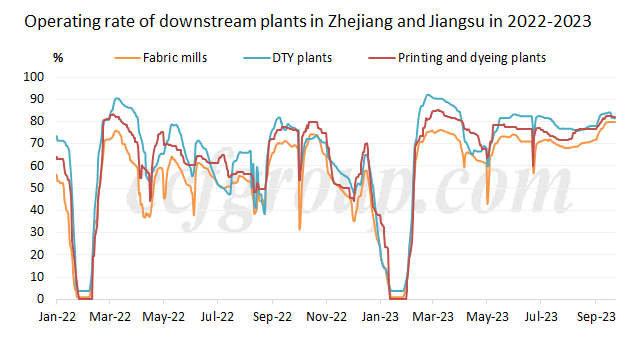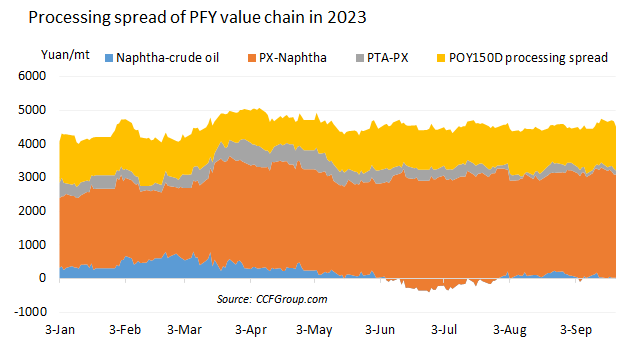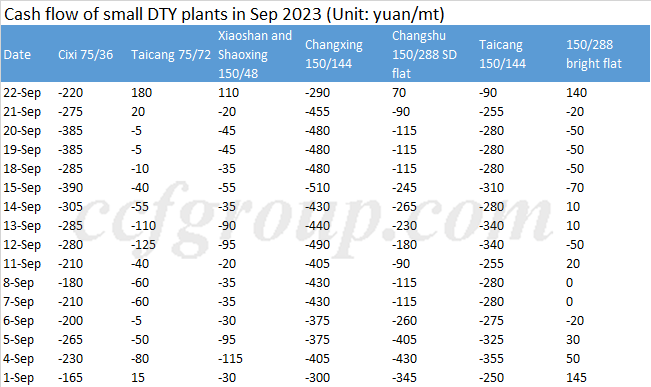Fabric manufacturing market: negative and positive feedback coexist
Since Aug, sales and production was balanced at first on fabric manufacturing market while the inventory rapidly fell later. The operating rate of fabric mills and printing and dyeing plants increased, which stimulated upstream feedstock market for around half a month. Downstream market is mixed with negative and positive feedback now.
The positive feedback is mainly reflected in the fact that after the inventory of grey fabrics rapidly declined, the overall inventory of grey fabrics is not high compared with the same period of last year. Comprehensive inventory of grey fabric has reduced to around 25 days in Zhejiang and Jiangsu, lower compared with the corresponding period of previous years, still having downward space compared with the low level in the second half of 2021.

After inventory descended, the operating rate of fabric mills, DTY plants and printing and dyeing plants climbed up in Sep.

Increasing negative news are appearing. Some players think the performance of peak season is not good, which are mainly reflected under the following two aspects:
Firstly, downstream buyers show higher resistance to high-priced resource. Factories worry the products produced by high-priced raw material will be depreciated later.

The processing spread and profit of PFY value chain still mainly relies on PX sector. Feedstock market has some risk to reduce. Therefore, the producers of textiles, apparels, fabrics and DTY become more worried of the deprecation of inventory.
Meanwhile, small DTY plants and fabric mills lack cash flow.
Most small DTY plants have suffered losses since Sep and the deficit of plants was especially obvious in Changxing, Cixi and Changshu.

Among mainstream conventional grey fabrics made from PFY, only some circular knitted imitation super-soft fabrics saw minor profit. The other varieties including polyester taffeta, flannel, brushed fabric and spandex super-soft fabric were all unprofitable.
Secondly, when inventory of grey fabrics declines, more payment needs to be collected. The control of capital risk strengthens.
Fabric mills and small DTY plants more need to collect payment when the inventory reduces smoothly. With the coming of Q4, the liquidity stock and account recovery pressure of some companies are relatively large.
As the year end approaches, some downstream factories will partially reduce leverage in their operations to reduce business risks. From a cost perspective, after current crude oil prices reaching the highest point of the year, there is an increased risk of depreciation in produced inventory.
As for the composition of peak season, domestic sales and export were both sound during the traditional peak season in Sep and Oct in previous years. This year, only domestic sales of some autumn and winter products are good now. Export orders for the Christmas Day and New Year's Day remain sluggish. Different fabric mills also witness diversified feelings. If the export orders still fail to improve much later, the peak season on fabric market may come to an end temporarily. Only some replenishment may appear for the seasonal autumn and winter products later. With the coming of Mid-autumn Festival and National Day holiday (Sep 29-Oct 6), the production activity of downstream plants recedes and some may shut down for holiday.
- Top keywords
- Cotton Price
- Cotton Futures Price
- Cotton Futures
- CZCE
- PTA Futures Price
- Chemical Fiber
- Polyester Prices
- Wool price
- PTA Futures
- Shengze Silk
- China
- Yarn Price
- price
- China Textile City
- Fibre Price
- Benzene Price
- Cotton
- Index
- Cotton Index
- PTA
- fabric price
- NYMEX
- Top 10
- textile industry
- Spot Cotton
- Cotton Yarn
- Polyester Price
- Futures
- PTA Price
- cotton yarn price

